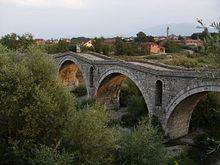Terzijski Bridge
Terzijski Bridge | |
|---|---|
 Terzijski bridge over the Erenik river | |
| Coordinates | 42°21′34″N 20°30′33″E / 42.35944°N 20.50917°ECoordinates: 42°21′34″N 20°30′33″E / 42.35944°N 20.50917°E |
| Carries | One (pedestrian) lane |
| Crosses | Erenik |
| Locale | Bistražin, near Gjakova |
| Heritage status | Monument of Culture of Exceptional Importance |
| Characteristics | |
| Design | Multi-arch |
| Total length | 190 m (620 ft) |
| Width | 3.5 m (11 ft) |
| History | |
| Opened | 15th century |
| Location | |
 | |
Terzijski Bridge (Serbian: Терзијски мост / Terzijski most, Albanian: Ura e Terzive, Turkish: Terzi Köprüsü, ), also referred to as Tailors' Bridge,[1] is located near the village of Bistražin, near Gjakova, Kosovo[a]. It is a respectable example of Ottoman architecture in Kosovo.[2] It was built over the Erenik river, probably at the end of the 15th century, and was altered in the 18th century. It is a noteworthy example of the guild from Gjakova, from which it received its name. Major reconstruction and restoration to its original appearance occurred from 1982 to 1984. Today, the bridge is under the protection of the Republic of Kosovo, originally being declared a Monument of Culture of Exceptional Importance in 1990 within Serbia.[3]
History[]
It is not known when exactly the bridge was built, but it is thought to have been at the end of the 15th century. This is due to the bridge having been erected on a medieval route, which connected Gjakova with Prizren, and that the bridge was later expanded (a result of changes of flow in the river). In the 18th century it experienced major modifications, which gave it its current appearance. These works were financed by the guild from Gjakova, confirmed by an inscription carved in Turkish.
The bridge was built with trimmed stones, in dark gray and an ocher shade. Its length exceeds 190 meters, the width of the pavement originally measuring over 3.5 meters. The bridge consists of 11 rounded arches, among which are embedded niches.
Notes[]
- ^ Kosovo is the subject of a territorial dispute between the Republic of Kosovo and the Republic of Serbia. The Republic of Kosovo unilaterally declared independence on 17 February 2008. Serbia continues to claim it as part of its own sovereign territory. The two governments began to normalise relations in 2013, as part of the 2013 Brussels Agreement. Kosovo is currently recognised as an independent state by 97 out of the 193 United Nations member states. In total, 112 UN member states have recognised Kosovo at some point, of which 15 later withdrew their recognition.
See also[]
- Monument of Culture of Exceptional Importance
- Gjakova
| Wikimedia Commons has media related to Terzijski Bridge. |
References[]
- ^ "Gjakova guide by In Your Pocket. A full, free guide to Gjakova/Đakovica, Kosovo, with hotels, restaurants, sights". Inyourpocket.com. Archived from the original on 2015-03-30. Retrieved 2015-04-10.
- ^ "Споменици културе у Србији". Spomenicikulture.mi.sanu.ac.rs. 1962-12-22. Retrieved 2015-04-10.
- ^ "Министарство културе и информисања". Kultura.gov.rs. Retrieved 2015-04-10.
- Bridges in Kosovo
- Cultural Monuments of Exceptional Importance (Serbia)
- Ottoman bridges in Kosovo
- Tourist attractions in Kosovo
- Cultural heritage of Kosovo
- Monuments and memorials in Kosovo
- Cultural Heritage of Serbia stubs
- European bridge (structure) stubs
- Kosovo stubs
- European building and structure stubs

